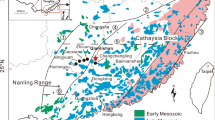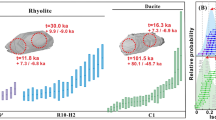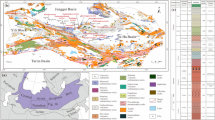Abstract
ALKALINE syenites in the Rallier-du-Baty peninsula of the Kerguelen Islands1,2 intrude and metamorphose the basaltic lava flows which constitute the major part of the islands3. Recent work4 has revealed the existence, in the peninsula, of five ring complexes consisting mainly of syenites containing from 2 to 15% normative quartz (Figs 1 and 2). The southern complex is the largest, and consists of nordmarkites (ring dykes a, b, c) and of quartz-rich syenites and alkaline granite (ring dykes d, e, f). Some minor intrusive bodies of gabbros (G) and nordmarkites (Σ) are located on the margins of the southern centre (Fig. 2). Chilled margins and enclaves in each individual ring dyke clearly indicate that the sequence of intrusions is centripetal. Furthermore, the contact relationships between the centres show that the magmatic activity has migrated northwards. Previous K–Ar data5 have indicated that a syenite from the southern ring complex was emplaced 8.7±0.9 Myr ago, whereas basaltic flows were erupted during the late Oligocene. An additional K–Ar age of 11.5±0.2 Myr was obtained for a metabasalt collected near the contact with the syenites and was interpreted3 as the minimum value for the time of eruption of the basalts.
This is a preview of subscription content, access via your institution
Access options
Subscribe to this journal
Receive 51 print issues and online access
$199.00 per year
only $3.90 per issue
Buy this article
- Purchase on Springer Link
- Instant access to full article PDF
Prices may be subject to local taxes which are calculated during checkout
Similar content being viewed by others
References
Lacroix, A., C. r. hebd. Séanc. Acad. Sci., Paris, 179, 113–119 (1924).
Aubert de la Rue, E., C. r. hebd. Séanc. Acad. Sci., Paris, 193, 863–866 (1931).
Nougier, J., Bull. Soc. Geol. Fr., 8, 567–576 (1966).
Marot, A., Zimine, S., and Lameyre, J., 3rd Reunion Annuelle des Sciences de a Terre, Montpellier, 248, 395 (1975).
Nougier, J., Com. natn. Francais Recherches Antarctiques, no. 27, 440 (1969).
Poland, K. A., Quinn, A. W., and Giletti, B. J., Am. J. Sci., 270, 321–330 (1971).
van Breemen, O., and Bowden, P., Nature phys. Sci., 242, 9–11 (1973).
van Breemen, O., Hutchinson, J., and Bowden, P., Contr. Miner. Petrol., 50, 157–172 (1975).
Foland, K. A., and Henderson, C. M. B., Earth planet. Sci. Lett., 29, 291–301 (1976).
Nougier, J., and Lameyre, J., Trans. Am. Geophys. Un., 53, 547 (1972).
Watkins, N. D., Gunn, B. M., Nougier, J., and Baksi, A. K., Bull. geol. Soc. Am., 85, 201–212 (1974).
Author information
Authors and Affiliations
Rights and permissions
About this article
Cite this article
LAMEYRE, J., MAROT, A., ZIMINE, S. et al. Chronological evolution of the Kerguelen Islands syenite–granite ring complex. Nature 263, 306–307 (1976). https://doi.org/10.1038/263306a0
Received:
Accepted:
Issue Date:
DOI: https://doi.org/10.1038/263306a0
This article is cited by
-
Isotopic characteristics of shoshonitic rocks in eastern Qinghai-Tibet Plateau: Petrogenesis and its tectonic implication
Science in China Series D: Earth Sciences (2001)
-
Age, origin and evolution of the anorogenic complex of Evisa (Corsica): A K-Li-Rb-Sr study
Contributions to Mineralogy and Petrology (1978)
Comments
By submitting a comment you agree to abide by our Terms and Community Guidelines. If you find something abusive or that does not comply with our terms or guidelines please flag it as inappropriate.



